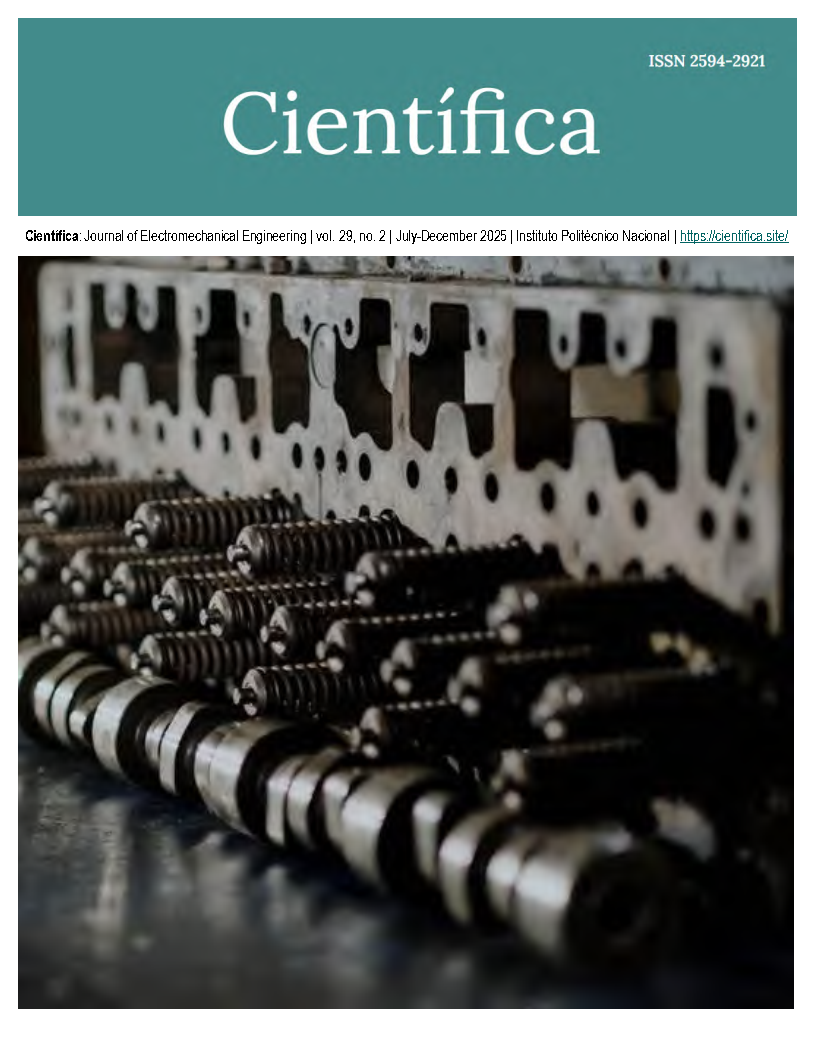Adaptive Preprocessing Optimization for Retinal Vascular Network Segmentation
DOI:
https://doi.org/10.46842/ipn.cien.v29n2a05Keywords:
image segmentation, fundus eye image, blood vessels, homomorphic filter, PSOAbstract
The segmentation of the vascular network in fundus images is a key step in the diagnosis and monitoring of ophthalmological and systemic pathologies, such as diabetic retinopathy (RD). However, the reliability of automated methods is challenged by inherent image issues, mainly non-uniform illumination, low contrast, and noise. This work proposes a methodology for the automated preprocessing and segmentation of fundus images, addressing these problems through an adaptation and regularization strategy. The method begins with the extraction of the green channel (G) to maximize contrast. Then, a Gaussian filter is applied, with its smoothing parameter (σ) optimized for each image by balancing noise reduction and detail preservation using the Variance of Laplacian (VoL) and High-Frequency Energy Residual (HFER). Next, a homomorphic filter is applied to correct illumination, with its parameters dynamically adjusted using a Particle Swarm Optimization (PSO) algorithm, employing Shannon entropy as the objective function. Finally, the Frangi filter is used to enhance tubular structures, followed by controlled binarization. The method was validated on the public DRIVE and STARE databases, where the homomorphic optimization stage showed a consistent increase in image entropy (e.g., from 5.7 to 6.2 bits/pixel), improving contrast. The proposed adaptive preprocessing strategy helps improve the reliability of vascular segmentation and, consequently, the diagnosis of related pathologies.
References
[1] M. D. Abràmoff, M. K. Garvin, M. Sonka, “Retinal Imaging and Image Analysis,” IEEE Reviews in Biomedical Engineering, vol. 3, pp. 169–208, 2010, doi: 10.1109/RBME.2010.2084567
[2] S. Yu, V. Lakshminarayanan, “Fractal Dimension and Retinal Pathology: A Meta-Analysis,” Applied Sciences, vol. 11, no. 5, Art. no. 5, Jan. 2021, doi: 10.3390/app11052376
[3] K. B. Khan et al., “A review of retinal blood vessels extraction techniques: challenges, taxonomy, and future trends,” Pattern Anal Applic, vol. 22, no. 3, pp. 767–802, Aug. 2019, doi: 10.1007/s10044-018-0754-8
[4] S. Dubey, M. Dixit, “Recent developments on computer aided systems for diagnosis of diabetic retinopathy: a review,” Multimed Tools Appl, vol. 82, no. 10, pp. 14471–14525, Apr. 2023, doi: 10.1007/s11042-022-13841-9
[5] M. R. K. Mookiah et al., “A review of machine learning methods for retinal blood vessel segmentation and artery/vein classification,” Medical Image Analysis, vol. 68, p. 101905, Feb. 2021, doi: 10.1016/j.media.2020.101905
[6] A. Khandouzi, A. Ariafar, Z. Mashayekhpour, M. Pazira, Y. Baleghi, “Retinal Vessel Segmentation, a Review of Classic and Deep Methods,” Ann Biomed Eng, vol. 50, no. 10, pp. 1292–1314, Oct. 2022, doi: 10.1007/s10439-022-03058-0
[7] W. Wang, W. Wang, Z. Hu, “Retinal vessel segmentation approach based on corrected morphological transformation and fractal dimension,” IET Image Processing, vol. 13, no. 13, pp. 2538–2547, Nov. 2019, doi: 10.1049/iet-ipr.2018.5636
[8] O. Ramos-Soto et al., “An efficient retinal blood vessel segmentation in eye fundus images by using optimized top-hat and homomorphic filtering,” Computer Methods and Programs in Biomedicine, vol. 201, p. 105949, Apr. 2021, doi: 10.1016/j.cmpb.2021.105949
[9] S. Biswas, M. I. A. Khan, M. T. Hossain, A. Biswas, T. Nakai, J. Rohdin, “Which Color Channel Is Better for Diagnosing Retinal Diseases Automatically in Color Fundus Photographs?,” Life, vol. 12, no. 7, p. 973, Jul. 2022, doi: 10.3390/life12070973
[10] S. Misra, Y. Wu, “Chapter 10 - Machine learning assisted segmentation of scanning electron microscopy images of organic-rich shales with feature extraction and feature ranking,” in Machine Learning for Subsurface Characterization, S. Misra, H. Li, J. He, Eds., Gulf Professional Publishing, 2020, pp. 289–314. doi: 10.1016/B978-0-12-817736-5.00010-7
[11] R. Bansal, G. Raj, T. Choudhury, “Blur image detection using Laplacian operator and Open-CV,” in 2016 International Conference System Modeling & Advancement in Research Trends (SMART), Moradabad, India, Nov. 2016, pp. 63–67. doi: 10.1109/SYSMART.2016.7894491
[12] Á. Chavarín, E. Cuevas, O. Avalos, J. Gálvez, M. Pérez-Cisneros, “Contrast Enhancement in Images by Homomorphic Filtering and Cluster-Chaotic Optimization,” IEEE Access, vol. 11, pp. 73803–73822, 2023, doi: 10.1109/ACCESS.2023.3287559
[13] R. C. Gonzalez, R. E. Woods, Digital Image Processing, 4th ed., Harlow, Essex, England: Pearson, 2018.
[14] D.-Y. Tsai, Y. Lee, E. Matsuyama, “Information Entropy Measure for Evaluation of Image Quality,” J Digit Imaging, vol. 21, no. 3, pp. 338–347, Sep. 2008, doi: 10.1007/s10278-007-9044-5
[15] A. F. Frangi, W. J. Niessen, K. L. Vincken, M. A. Viergever, “Multiscale vessel enhancement filtering,” in Medical Image Computing and Computer-Assisted Intervention — MICCAI’98, W. M. Wells, A. Colchester, and S. Delp, Eds., Berlin, Heidelberg: Springer, 1998, pp. 130–137. doi: 10.1007/BFb0056195
[16] A. Khawaja, T. M. Khan, K. Naveed, S. S. Naqvi, N. U. Rehman, S. Junaid Nawaz, “An Improved Retinal Vessel Segmentation Framework Using Frangi Filter Coupled with the Probabilistic Patch Based Denoiser,” IEEE Access, vol. 7, pp. 164344–164361, 2019, doi: 10.1109/ACCESS.2019.2953259
[17] D. Jimenez-Carretero, A. Santos, S. Kerkstra, R. D. Rudyanto, M. J. Ledesma-Carbayo, “3D Frangi-based lung vessel enhancement filter penalizing airways,” in 2013 IEEE 10th International Symposium on Biomedical Imaging, San Francisco, CA, USA, Apr. 2013, pp. 926–929. doi: 10.1109/ISBI.2013.6556627
[18] A. Khawaja, T. M. Khan, K. Naveed, S. S. Naqvi, N. U. Rehman, S. Junaid Nawaz, “An Improved Retinal Vessel Segmentation Framework Using Frangi Filter Coupled With the Probabilistic Patch Based Denoiser,” IEEE Access, vol. 7, pp. 164344–164361, 2019, doi: 10.1109/ACCESS.2019.2953259
Downloads
Published
Issue
Section
License
Copyright (c) 2025 Evelyn Berenice Bautista Coello, Álvaro Anzueto Ríos, Alma Aide Sánchez Ramirez (Autor/a)

This work is licensed under a Creative Commons Attribution-NonCommercial-ShareAlike 4.0 International License.

